- Clinical Technology
- Adult Immunization
- Hepatology
- Pediatric Immunization
- Screening
- Psychiatry
- Allergy
- Women's Health
- Cardiology
- Pediatrics
- Dermatology
- Endocrinology
- Pain Management
- Gastroenterology
- Infectious Disease
- Obesity Medicine
- Rheumatology
- Nephrology
- Neurology
- Pulmonology
Asthma Disease Burden and Formulary Decision Making: MCO and Employer Perspectives
Asthma affects approximately 22 million adults and children in the United States and poses a significant economic burden on the health care system and on employers. According to the National Heart, Lung, and Blood Institute, direct and indirect costs for all forms of asthma totaled $19.7 billion in 2007. Prescription drugs represented the largest single direct cost at $6.2 billion.
In 2005, an estimated 22.2 million US adults and children (7.7% of the population) had asthma.1 Asthma prevalence is approximately twice as high in women 18 years and older than in men. In children younger than 18 years, however, this pattern is reversed: about 30% more boys than girls have received a diagnosis of asthma. Moreover, the incidence of asthma has dramatically increased over the past several decades in the United States.2 The self-reported prevalence of asthma among adults and children doubled from 6.8 million in 1980 to 13.7 million in 1994.
Asthma poses a significant economic burden on the health care system, contributing to impaired quality of life,3 missed school days and workdays,4 and increased health care utilization4,5 and costs.5-7 Data from the National Center for Health Statistics showed that in 2003, 10.1 million workdays and 12.8 million school days were missed because of asthma.8
The National Heart, Lung, and Blood Institute estimated that in 2007, overall US costs for all forms of asthma were $19.7 billion, of which direct health care expenditures were $14.7 billion. Prescription drugs represented the largest single direct cost at $6.2 billion.9
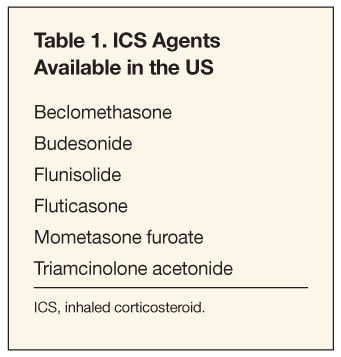
Many safe and efficacious pharmacological agents are available for controlling asthma symptoms. These agents are designed for specific purposes (eg, long-term control, quick relief) and have different mechanisms of action (eg, bronchodilator, anti-inflammatory). The National Asthma Education and Prevention Program (NAEPP) Expert Panel Report 3, which includes the NAEPP’s updated 2007 guidelines for the diagnosis and management of asthma, concludes that inhaled corticosteroid (ICS) drugs are the most potent and consistently effective long-term, anti-inflammatory asthma control medications.10 Table 1 lists the generic names of ICS drugs that are available in the United States. Long-term control medications are recommended for daily use for the control of chronic asthma (eg, patients who have asthma symptoms more often than twice a week during the day or more than twice a month at night).10
The asthma burden both in the United States and worldwide is well established. Adherence to the NAEPP guidelines for asthma pharmacotherapy is associated with improved health care resource utilization, such as fewer visits to the emergency department (ED),11 fewer hospitalizations,12 and lower costs.13 In addition, practice guidelines combined with disease-state management (DSM) programs are associated with improved asthma outcomes in the form of decreased resource utilization and costs as well as increased productivity and improved overall quality of life.14 Few studies, if any, have evaluated the asthma burden from the perspective of managed care and employer formulary decision makers or assessed salient attributes involved in the formulary decision-making process.
The purposes of our interviews and analysis were (1) to assess asthma burden and the outcome of current management strategies from the perspective of MCOs and employers, and (2) to determine the most important product attributes that drive formulary decision making. This article provides a descriptive review of our findings.
Methods
During the fourth quarter of 2007, 10 MCO decision makers (medical directors and pharmacy directors) and 8 employer decision makers (benefit managers and medical directors) were interviewed by telephone. Participants were from both national and regional service areas with plans that provide coverage for more than 51 million persons.
We obtained qualitative data during the structured 45- to 60-minute telephone interviews. Our research focused on asthma disease burden, disease-management strategies, and asthma formulary management. We also examined product attributes of an emerging ICS therapy that may influence the formulary decision-making process and product inclusion (eg, adding a drug to a formulary, tier placement). Participants were blinded regarding product name. Mean ratings on a 10-point semantic differential scale ranged from 1 (no impact, not at all important/very unfavorable, or not at all likely) to 10 (extremely large impact, very large impact, very important/very favorable, or very likely). Our study was not designed to measure statistical significance, so interpretation of our findings, which are primarily qualitative, should take this into account.
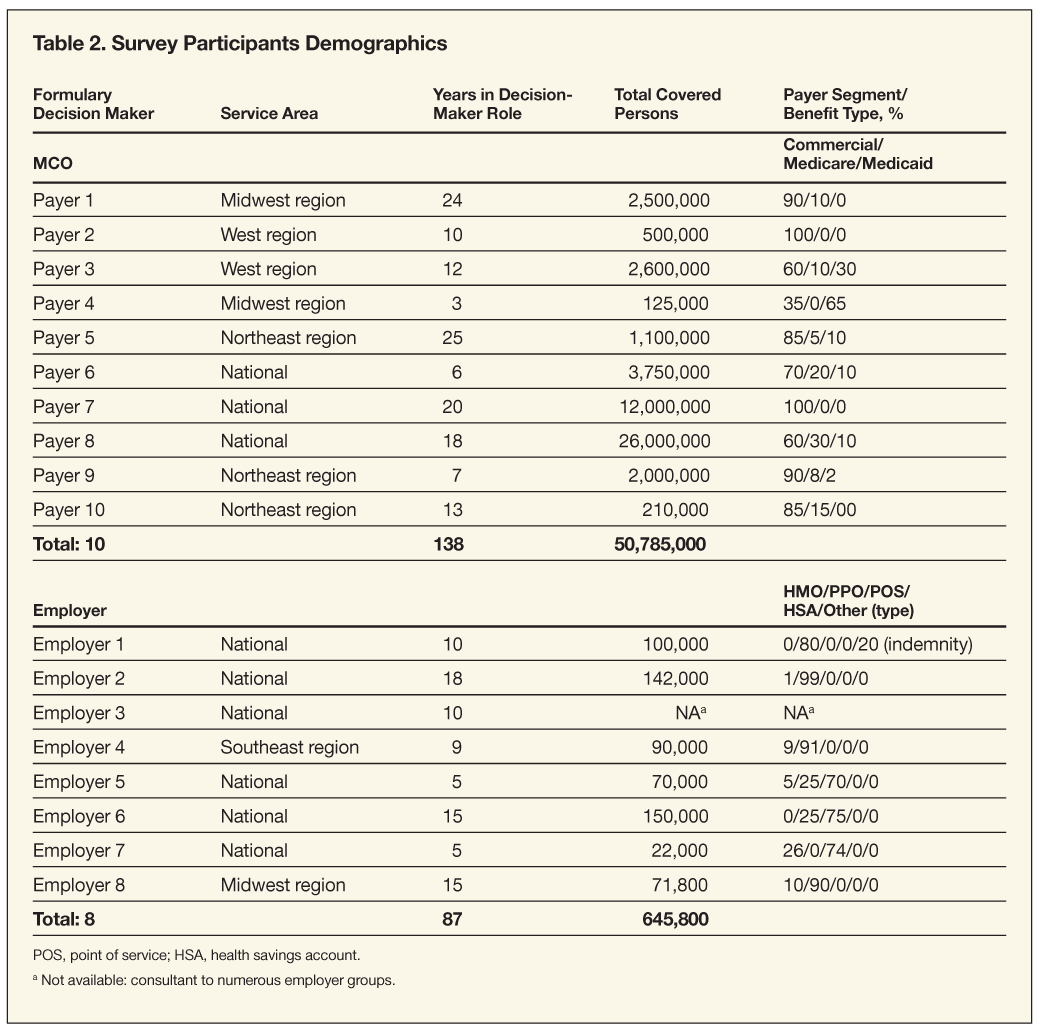
Results Demographics. The 18 participants represented all major geographical regions of the United States and had a combined total of 225 years of experience as formulary decision makers. Health plans included commercial and government (Medicare and Medicaid) programs. Employer plans consisted primarily of HMOs, PPOs, health savings accounts, and point-of-service plans. Demographic characteristics of the participants are shown in Table 2.
Asthma disease burden. Using pharmacy claims and utilization data, participants estimated that the prevalence of asthma in their respective plan populations ranged from 2% to 8%, with the majority of respondents (54% [7 of 13]) reporting a prevalence between 3% and 6%. Participants from MCOs were asked to segment the asthma population of their plans between adults and children. Among 3 of the 10 respondents who were able to provide such figures, asthma prevalence in the pediatric population ranged from 30% to 60%. Rates of disease severity varied widely, with the rate of severe asthma ranging from 1% to 25% among plans (n = 12).
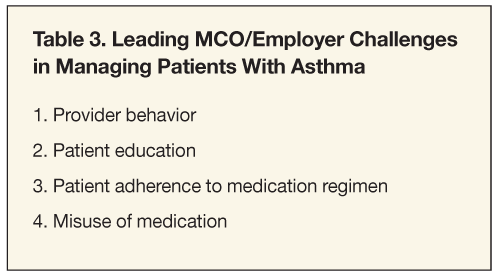
Both MCO decision makers and employers were asked to state what they perceived to be the greatest challenge in managing member populations with asthma. Leading responses included health care provider behavior, patient education, patient adherence, and misuse of medication (Table 3). Other responses included employer understanding of the nature of asthma as a chronic disease, managing allergies along with asthma, financial barriers, and a lack of outcome measurements that focus on treatment success.
Currently, most participants (94% [17 of 18]) have a DSM program for asthma, which typically identifies patients through claims data. The intervention levels varied from mail and telephone messages to consultations with nurses. While most participants (78% [14 of 18]) said they believe these programs to be beneficial, evidence is limited beyond participation and satisfaction data. Three participants indicated an interest in using these programs to improve performance on Healthcare Effectiveness Data and Information Set (HEDIS) measures. Two employers recommended one-on-one communication between patients and health care providers to improve disease status and prognosis and continuously improve quality; improvements in disease status and prognosis were observed among members who had worked with a health coach early in treatment.
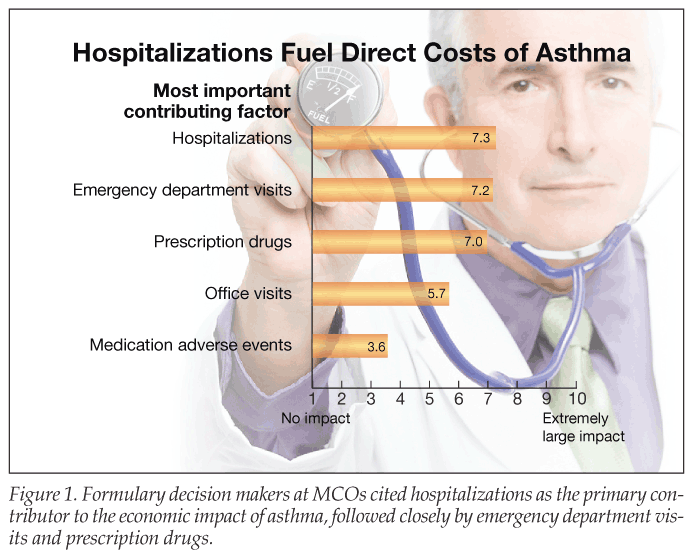
Participants were asked whether comorbid conditions, such as allergic rhinitis, affect the way they approach asthma management. The majority of MCO and employer decision makers (61% [11 of 18]) said they do not think that allergic rhinitis complicates the way asthma is managed, stating that health care providers are affected more than health plans. However, 2 participants recognized that closer scrutiny of pharmacy claims in relation to the diagnosis of asthma and allergic rhinitis is necessary because providers sometimes use these terms interchangeably.
Using a 10-point semantic differential scale, MCO decision makers reported that the economic impact of asthma was most notable for hospitalizations (7.3), ED visits (7.2), and prescription drugs (7.0), followed by office visits (5.7) and medication adverse events (3.6) (Figure 1). Employers used a similar 10-point semantic differential scale to indicate the impact of asthma on employee absenteeism (6.0), workplace productivity (5.4), employee presenteeism (5.3), and employer health care costs (5.3) (Figure 2). These responses take into account employees with asthma and/or their dependent children who have asthma.
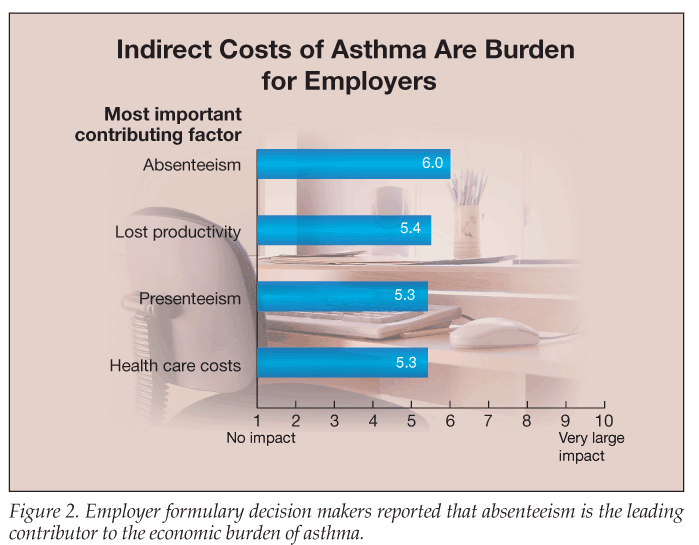
Asthma formulary management. MCO decision makers reported that (in descending order) efficacy/ safety, cost-effectiveness/value, and adherence were the most important product attributes driving formulary decision making for an ICS medication (Table 4). In general, these are the same factors that were reported to determine tier placement for a new ICS medication. However, cost played a much larger role in the tier process for a new ICS drug than for established ICS drugs.
The majority of MCO decision makers (6 of 10) said they did not anticipate any changes in the management of ICS products on their formulary, at least not in the near future. Other MCO decision makers (3 of 10) reported that they expect the introduction of generic versions to have a considerable impact on formulary decision making.
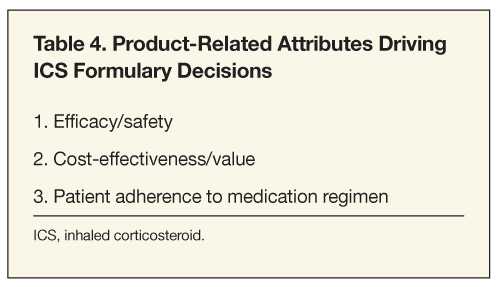
Disease-management strategies. Most participants in the employer group (6 of 8) had the authority to provide in-put to their health plan manager or PBM on formulary issues. Such input was generally limited to medication classes rather than specific drugs. Employers said it is important for employees with asthma to have access to new ICS products on the formulary (5.9) and maintained that high copays or high coinsurance cost-sharing can adversely impact medication utilization and adherence among persons with asthma (6.6).
Product attributes. In regard to specific attributes of the new ICS product, MCO decision makers used a 10-point semantic differential scale to indicate that improved patient adherence (8.4), once-daily dosing frequency (6.9), and decreased risk of systemic toxicity (eg, lower serum cortisol suppression) (6.1) were also important in formulary decision making (Figure 3). In addition, the MCO group reported that significantly fewer local adverse events (eg, candidiasis [oral thrush] or dysphonia [hoarseness]) would be important in formulary decision making (5.8). The majority of respondents (8 of 10) thought that such adverse events would have to decrease by more than 25% for the decline to be considered clinically significant. Based on product attributes described (eg, smaller particle size, once-daily dosing, favorable adverse-event profile), MCO decision makers had an overall favorable opinion of the new ICS product (6.9). The most important attributes, in order of importance, were once-daily dosing (7 of 10), smaller particle size for greater deposition to the lungs (4 of 10), and favorable adverse-event profile and cost (each with 3 of 10). Employer decision makers also reported high ratings for improved patient adherence (8.9) and an overall favorable opinion of the new ICS medication (6.8).
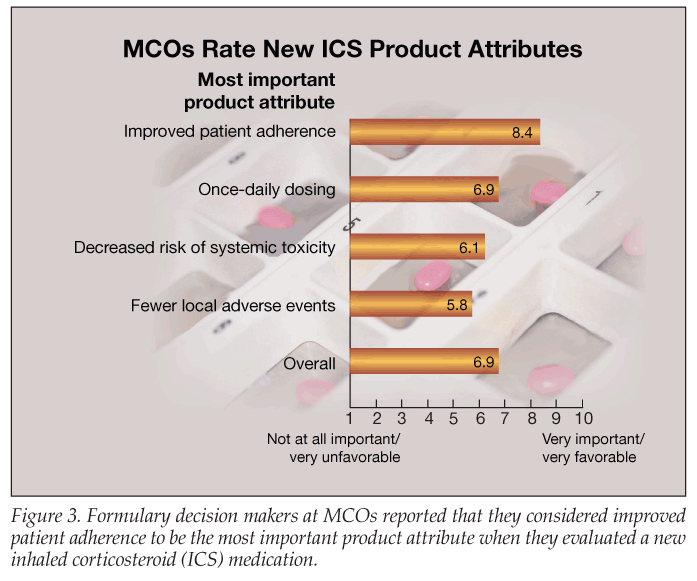
Product inclusion. Based on the product attributes described, employer decision makers used the same 10-point semantic differential scale to indicate that the new ICS product would be an important addition to their health plan formulary (6.5). The MCO decision makers identified some additional information that would be useful in the formulary decision-making process, including head-to-head trials, health care resource utilization (eg, ED or inpatient visits), data on ease of use and administration, quantifiable data on the adverse-event profile, the comparative event-reduction profile, pharmacoeconomic studies (eg, cost-effectiveness), pricing and rebates, and contract information.
Most MCO decision makers (9 of 10) indicated a low likelihood (2.6) of the new ICS product being approved for reimbursement and added to the formulary at the time of product launch because of formulary time lines and safety moratoria. The MCO group thought a more realistic time line for product inclusion would be 6 months after product launch (7).
MCO decision makers emphasized that the new product would need to be priced competitively-10% lower than comparable ICS medications-to secure favorable positioning in the crowded ICS market.
Discussion
While MCO and employer decision makers recognize the pervasiveness of asthma and the challenges associated with managing the disease, they may not be fully cognizant of the true prevalence of asthma in their plan populations. Participants reported an asthma prevalence of 3% to 6% in their plan populations, which is lower than the national prevalence of 7.6% of the population. When children are excluded from this estimate, the prevalence of asthma (in adults 18 years and older) in the United States is 7.2%.1 Some participants suggested that a diagnosis of asthma might not always be correctly interpreted using pharmacy claims.
Participants rated provider behavior, patient education, patient adherence, and misuse of medication as examples of the challenges associated with asthma management. Accurately diagnosing asthma can be difficult.15 Other conditions can mimic or occur simultaneously with asthma. Once a patient’s asthma is accurately diagnosed, provider behavior may differ with regard to treatment strategy. It is essential for providers to follow nationally accepted guidelines for asthma management.16 However, even with the proper treatment strategy in place, patient adherence may be lacking. Indeed, some surveys have shown that only half of patients who have received a prescription for an ICS use it on a regular basis.16 Patient education may help improve adherence. Emphasis on self-management skills rather than merely asthma education is more likely to result in success, especially when combined with a collaborative approach by providers and supportive staff.15
Interestingly, MCO decision makers rated pharmaceutical costs almost as high as ED visits and hospitalizations in terms of the economic impact of asthma, which suggests that the potential cost savings of pharmacotherapy may not be fully appreciated. Findings of a study that evaluated the economic costs associated with asthma indicated that prescription medications accounted for only 14% of the total health care costs of the disease.5 Most of the direct costs were related to ambulatory visits and hospitalizations. In addition, numerous studies have highlighted the decrease in resource utilization and subsequent cost reductions as a result of asthma management with pharmacotherapy according to practice guidelines.11-13,17 A cost-effectiveness model may help demonstrate the benefit of long-term therapy in relation to controlling asthma symptoms and preventing exacerbations. There is a great deal of evidence of the benefits of incorporating pharmacoeconomic models into the formulary decision-making process for third-party payers.16,18-20
While adequately controlled asthma can be associated with lower costs and decreased resource utilization, inappropriate use (eg, underuse or overuse) can be associated with increased health care costs and utilization.21-24Admittedly, in some instances, medication adverse events may be a contributing factor and also may affect patient adherence. Although ICS medications are generally well tolerated, local and systemic adverse events may occur. In one study, researchers analyzed the impact of ICS-induced oropharyngeal adverse events (eg, dysphonia, sore throat, oral candidiasis) and found an increase in the economic burden associated with subsequent physician office visits related to treatments for adverse events totaling approximately $464 million.25
Although we recognize that numerous factors are involved in the complex process of formulary decision making, our findings demonstrate that MCO decision makers consider efficacy, safety, cost-effectiveness/value, and patient adherence as the most important product attributes that would influence formulary placement of a new ICS. Formulary decisions are based on a compilation of input that takes into account not only specific product attributes but the competitive landscape and existing contracts, among other factors. Researchers who evaluated formulary decision-making variations among organizations found that a number of MCO characteristics, including size of the Medicare/Medicaid population, size and makeup of the pharmacy and therapeutics committee, pharmacy-director incentives for controlling drug costs, and frequency of interaction with pharmaceutical manufacturer representatives, have an impact on formulary adoption.26-28 Further evaluation of this issue is warranted.
The success of DSM programs has been well documented.14,29-32 The Asheville Project, started in 1996, in which community pharmacists provided education and individual oversight for city employees of Asheville, NC, with chronic conditions, such as asthma and diabetes, demonstrated sustained improvement in asthma control for up to 5 years (N = 207).32 Among city employees, ED visits decreased from 9.9% to 1.3% and hospitalizations decreased from 4% to 1.9% during the study period. Although medication costs increased from $1178 to $1379 in the period, overall asthma-related costs decreased. Direct cost savings averaged $725 per patient per year, and indirect cost savings were estimated to be $1230 per patient per year. Indirect costs because of missed or nonproductive workdays decreased from 10.8 days per year to 2.6 days per year.
Despite such evidence, participants said that although it seems intuitive that DSM programs would be beneficial, it is difficult to mea-sure their success, partly because of the need for long-term monitoring. However, they acknowledge that based on these findings, it would be prudent to increase efforts to implement these programs and monitor outcomes.
Interpretation of these findings is constrained by some limitations. This exploratory research was designed as a qualitative study. The study data do not support statistical inference, so the study results should be interpreted accordingly. Although the 18 study participants represented plans that provide coverage for more than 51 million persons at regional and national MCOs and employers, the small sample may not be representative of this decision-making population. Additional quantitative survey research would be necessary to validate the findings. Because the study design called for telephone interviews, participants could have been subject to recall bias. Also, the data source on which participants were basing feedback may have been limited because of the nature of claims data-an incorrect or missing diagnostic code can alter findings. In addition, employee absenteeism may not have been directly related to an employee having asthma but to a child with the condition. Also, some of the findings, such as the influence of presenteeism, are difficult to measure, as one of the participants observed.
The results of this study are based on the asthmatic population and, more specifically, are related to ICS therapy. However, these findings can be applied in a broad sense to other diseases to help understand some considerations that affect formulary decisions. Postlaunch evidentiary requirements may include the need for “real-world,” head-to-head, comparative- effectiveness studies.
Conclusion
MCO and employer formulary decision makers had a similar awareness of asthma burden and similar priorities with respect to asthma management and formulary decision making. Efficacy, safety, cost, and adherence remain the primary factors that influence formulary decision making. Given these common interests and priorities, meaningful collaboration among MCOs and employers to improve asthma care and management is desirable. Potential cost savings through appropriate pharmacotherapy should be of significant value to MCOs and employers in promoting efforts to reduce the burden of asthma in their patient populations and to their plans.
Acknowledgment
This study was supported by Sanofi-Aventis.
Note: A poster summarizing the study findings was presented at the International Society for Pharmacoeconomics and Outcomes Research (ISPOR) 13th Annual International Meeting; May 3-7, 2008; Toronto.
References:
References
1. Adams PF, Dey AN, Vickerie JL. Summary health statistics for the US population: National Health Interview Survey, 2005. Vital Health Stat 10. 2007;233:1-104.
2. Mannino DM, Homa DM, Pertowski CA, et al. Surveillance for asthma-United States, 1960-1995. MMWR CDC Surveill Summ. 1998;47:1-27.
3. Ekici A, Ekici M, Kara T, et al. Negative mood and quality of life in patients with asthma. Qual Life Res. 2006;15:49-56.
4. Fuhlbrigge AL, Adams RJ, Guilbert TW, et al. The burden of asthma in the United States: level and distribution are dependent on interpretation of the National Asthma Education and Prevention Program guidelines. Am J Respir Crit Care Med. 2002;166:1044-1049.
5. Smith DH, Malone DC, Lawson KA, et al. A national estimate of the economic costs of asthma. Am J Respir Crit Care Med. 1997;156(3, pt 1):787-793.
6. Stanford R, McLaughlin T, Okamoto LJ. The cost of asthma in the emergency department and hospital. Am J Respir Crit Care Med. 1999;160:211-215.
7. Piecoro LT, Potoski M, Talbert JC, Doherty DE. Asthma prevalence, cost, and adherence with expert guidelines on the utilization of health care services and costs in a state Medicaid population. Health Serv Res. 2001;36:357-371.
8. Akinbami L. Asthma prevalence, health care use and mortality: United States, 2003-2005. National Center for Health Statistics, Centers for Disease Control and Prevention. www.cdc.gov/nchs/products/pubs/pubd/hestats/ashtma03-05/asthma03-05.htm. Published November 2006. Accessed January 6, 2009.
9. National Heart, Lung, and Blood Institute. Morbidity & mortality: 2007 chart book on cardiovascular, lung, and blood diseases. www.nhlbi.nih.gov/resources/docs/cht-book.htm. Accessed January 6, 2009.
10. National Asthma Education and Prevention Program. Expert Panel Report 3 (EPR-3): guidelines for the diagnosis and management of asthma’summary report 2007. J Allergy Clin Immunol. 2007;120:S94-S138.
11. Laumann JM, Bjornson DC. Treatment of Medicaid patients with asthma: comparison with treatment guidelines using disease-based drug utilization review. Ann Pharmacother. 1998;32: 1290-1294.
12. Donahue JG, Weiss ST, Livingston JM, et al. Inhaled steroids and the risk of hospitalization for asthma. JAMA. 1997;277:887-891.
13. Balkrishnan R, Norwood GJ, Anderson A. Outcomes and cost benefits associated with the introduction of inhaled corticosteroid therapy in a Medicaid population of asthmatic patients. Clin Ther. 1998;20:567-580.
14. Jowers JR, Schwartz AL, Tinkelman DG, et al. Disease management program improves asthma outcomes. Am J Manag Care. 2000;6:585-592.
15. Kercsmar CM. Meeting the challenges of asthma: conference summary. Respir Care. 2008;53: 787-795.
16. O’Connor RD. Current approaches to asthma management: assessing clinical and economic evidence. J Manag Care Pharm. 2002;8(5 suppl):8-17.
17. Goldfarb N, Weston C, Hartmann CW, et al. Impact of appropriate pharmaceutical therapy for chronic conditions on direct medical costs and workplace productivity: a review of the literature. Dis Manag. 2004;7:61-75.
18. Suh DC, Okpara IR, Agnese WB, Toscani M. Application of pharmacoeconomics to formulary decision making in managed care organizations. Am J Manag Care. 2002;8:161-169.
19. Watkins JB, Minshall ME, Sullivan SD. Application of economic analyses in US managed care formulary decisions: a private payer’s experience. J Manag Care Pharm. 2006;12:726-735.
20. Sanchez LA. Pharmacoeconomics and formulary decision making. Pharmacoeconomics. 1996;9 (suppl 1):16-25.
21. Anis AH, Lynd LD, Wang XH, et al. Double trouble: impact of inappropriate use of asthma medication on the use of health care resources. CMAJ. 2001;164:625-631.
22. Chen H, Gould MK, Blanc PD, et al. Asthma control, severity, and quality of life: quantifying the effect of uncontrolled disease. J Allergy Clin Immunol. 2007;120:396-402.
23. Sullivan SD, Rasouliyan L, Russo PA, et al. Extent, patterns, and burden of uncontrolled disease in severe or difficult-to-treat asthma. Allergy. 2007;62:126-133.
24. Diette GB, Wu AW, Skinner EA, et al. Treatment patterns among adult patients with asthma: factors associated with overuse of inhaled beta-agonists and underuse of inhaled corticosteroids. Arch Intern Med. 1999;159:2697-2704.
25. Kaliner M, Amin A, Gehling R, et al. Impact of inhaled corticosteroid-induced oropharyngeal adverse effects on treatment patterns and costs in asthmatic patients: results from a Delphi panel. P&T. 2005;30:573-601.
26. Dranove D, Hughes EF, Shanley M. Determinants of HMO formulary adoption decisions. Health Serv Res. 2003;38(1, pt 1):169-190.
27. Money W, Gilfillan D, Duncan R. A comparative study of multi-unit health care organizations. In: McCool BP, Brown M, eds. Multihospital Systems. Germantown, MD: Aspen Systems; 1980:367-413.
28. Mohrman SA, Cohen SG, Mohrman AM. Designing Team-Based Organizations. San Francisco: Jossey-Bass; 1995.
29. Linden A, Berg GD, Wadhwa S. Evaluation of a Medicaid asthma disease management program. Dis Manag. 2007;10:266-272.
30. Afifi AA, Morisky DE, Kominski GF, Kotlerman JB. Impact of disease management on health care utilization: evidence from the “Florida: A Health State (FAHS)” Medicaid Program. Prev Med. 2007;44:547-553.
31. Clark NM, Gong ZM, Wang SJ, et al. A randomized trial of a self-regulation intervention for women with asthma. Chest. 2007;132:88-97.
32. Bunting BA, Cranor CW. The Asheville Project: long-term clinical, humanistic, and economic outcomes of a community-based medication therapy management program for asthma. J Am Pharm Assoc. 2006;46:133-147.
